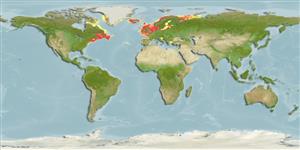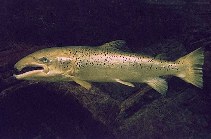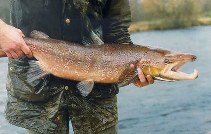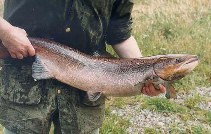把你的觀察加入 Fish Watcher
| Native range | All suitable habitat | Point map | Year 2050 |

|
| This map was computer-generated and has not yet been reviewed. |
| Salmo salar AquaMaps Data sources: GBIF OBIS |
Spain country information
Common names:
N. Atlantic salmon, Salmó, Salmón
Occurrence: native
Salinity: freshwater
Abundance: | Ref:
Importance: commercial | Ref: FAO, 1994
Aquaculture: commercial | Ref: FAO Fishery Information, Data and Statistics Service, 1993
Regulations: | Ref:
Uses: live export: yes;
Comments: Historical records from Duero, Tagus and Guadiana are now extirpated (Ref. 59043). Found in the Iberian Peninsula (Ref. 119049). Recorded from Galicia (Ref. 86578) in the river Minho (Ref. 88171). Threatened due to construction of dams, habitat desctruction, and pollution (Ref. 79582). Minimum capture size: 40-55 cm TL (Ref. 119049). Also Ref. 173, 59043. Status of threat: vulnerable (Ref. 79582, 119049).
National Checklist:
Country Information: https://www.cia.gov/library/publications/resources/the-world-factbook/geos/sp.html
National Fisheries Authority:
Occurrences: Occurrences Point map
Main Ref: Elvira, B., 1996
National Database: ICTIMED
Occurrence: native
Salinity: freshwater
Abundance: | Ref:
Importance: commercial | Ref: FAO, 1994
Aquaculture: commercial | Ref: FAO Fishery Information, Data and Statistics Service, 1993
Regulations: | Ref:
Uses: live export: yes;
Comments: Historical records from Duero, Tagus and Guadiana are now extirpated (Ref. 59043). Found in the Iberian Peninsula (Ref. 119049). Recorded from Galicia (Ref. 86578) in the river Minho (Ref. 88171). Threatened due to construction of dams, habitat desctruction, and pollution (Ref. 79582). Minimum capture size: 40-55 cm TL (Ref. 119049). Also Ref. 173, 59043. Status of threat: vulnerable (Ref. 79582, 119049).
National Checklist:
Country Information: https://www.cia.gov/library/publications/resources/the-world-factbook/geos/sp.html
National Fisheries Authority:
Occurrences: Occurrences Point map
Main Ref: Elvira, B., 1996
National Database: ICTIMED
Common names from other countries
分類 / Names 俗名 | 同種異名 | Catalog of Fishes(屬, 種) | ITIS | CoL | WoRMS | Cloffa
Teleostei > Salmoniformes (Salmons) 鮭形目 (Salmons) > Salmonidae (Salmonids) 鮭科 (Salmonids) > Salmoninae
Etymology: Salmo: Latin, salmo, Plinius = salmon (Ref. 45335); salar: From the Latin 'salio' meaning to leap (Ref. 6885).
More on author: Linnaeus.
Etymology: Salmo: Latin, salmo, Plinius = salmon (Ref. 45335); salar: From the Latin 'salio' meaning to leap (Ref. 6885).
More on author: Linnaeus.
Environment: milieu / climate zone / depth range / distribution range 生態學
海洋; 淡水; 半鹹淡水 底中水層性; 溯河洄游 (Ref. 92381); 深度上下限 0 - 210 m (Ref. 57178), usually 10 - 23 m. 溫帶; 2°C - 9°C (Ref. 36794); 72°N - 37°N, 77°W - 61°E
分布 國家 | FAO區域 | 生態系 | 發現紀錄 | Point map | 簡介 | Faunafri
North Atlantic Ocean: temperate and arctic zones in northern hemisphere (Ref. 51442).
Western Atlantic: Atlantic drainages from northern Quebec, Canada, to Connecticut and New York, USA; inland to Lake Ontario where it is now extirpated (Ref. 86798). Landlocked stocks are present in North America (Ref. 1998). Eastern Atlantic: White and Barents Sea basins through northeastern Europe to the Baltic and North Sea basins, including Iceland (Ref. 59043). Introduced to New Zealand, Chile, southern Argentina (Ref. 59043) and Australia (Ref. 6390).
大西洋: 在北半球中的溫帶與北極的區域.(參考文獻 51442) 在大西洋西部海洋中在美國 (參考文獻 5723) 到阿根廷分佈於來自北方的加拿大魁北克與肯乃迪克州的海岸流域。 (參考文獻 9086) 在分佈於流域從波羅的海東大西洋的海洋中說到葡萄牙。 (參考文獻 51442) 陸封的分枝在俄國,芬蘭,瑞典與挪威 (參考文獻 6439) 與北美洲出現。 (參考文獻 1998) 伯恩公約的附錄 3(受保育的動物群; 除了在海上之外).
大西洋: 在北半球中的溫帶與北極的區域.(參考文獻 51442) 在大西洋西部海洋中在美國 (參考文獻 5723) 到阿根廷分佈於來自北方的加拿大魁北克與肯乃迪克州的海岸流域。 (參考文獻 9086) 在分佈於流域從波羅的海東大西洋的海洋中說到葡萄牙。 (參考文獻 51442) 陸封的分枝在俄國,芬蘭,瑞典與挪威 (參考文獻 6439) 與北美洲出現。 (參考文獻 1998) 伯恩公約的附錄 3(受保育的動物群; 除了在海上之外).
Length at first maturity / 大小 / 重量 / 年齡
Maturity: Lm 73.1 range ? - ? cm
Max length : 150 cm TL 雄魚/尚未辨別雌雄; (Ref. 7251); 120.0 cm TL (female); common length : 38.0 cm TL 雄魚/尚未辨別雌雄; (Ref. 3561); 最大體重: 46.8 kg (Ref. 41037); 最大年齡: 13 年 (Ref. 274)
Max length : 150 cm TL 雄魚/尚未辨別雌雄; (Ref. 7251); 120.0 cm TL (female); common length : 38.0 cm TL 雄魚/尚未辨別雌雄; (Ref. 3561); 最大體重: 46.8 kg (Ref. 41037); 最大年齡: 13 年 (Ref. 274)
簡短描述 檢索表 | 型態特徵 | 形態測量圖
背棘 (總數) : 3 - 4; 背的軟條 (總數) : 9 - 15; 臀棘: 3 - 4; 臀鰭軟條: 7 - 11; 脊椎骨: 58 - 61. Distinguished from congeners by having the following unique characters: 10-13 scales between end of adipose base and lateral line; 17-24 gill rakers (Ref. 59043); caudal fin deeply forked in individuals smaller than 20 cm SL; hyaline or grey adipose margin; posterior part of vomer toothless (Ref. 59043). Mouth extends only to area below rear of eye and has well developed teeth (Ref. 51442). Vomerine teeth weak (Ref. 7251). Caudal fin with 19 rays (Ref. 2196). Little scales (Ref. 51442). Juveniles have 8-12 blue-violet spots on the flanks with little red spots in-between (Ref. 51442). Adults at sea are bluish-green dorsally becoming silvery along the sides and white ventrally; with a few black spots but none under lateral line (Ref. 37032, Ref. 51442). Caudal fin usually unspotted and adipose fin not black bordered. During reproduction individuals lose the silvery shine and become dull brown or yellowish. Males may be mottled with red or have large black patches (Refs. 37032, 51442, 88171). Skin becomes thick and leathery. Survivors lose their spawning coloration and are generally dark in colour (Ref. 84357). During the spawning season, males are characterized by elongated hooked jaws that meet at the tips, thicker fins, and slime covering their body. Hook of males dwindle after spawning (Ref. 35388).
紡錘型身體.(參考文獻 51442) 嘴只在眼後面之下延伸到區域而且有發展良好的齒。 (參考文獻 51442) 犛骨齒弱的.(參考文獻 7251) 尾鰭有 19個鰭條。 (參考文獻 2196) 小的鱗片.(參考文獻 51442) 成魚是藍綠色色彩在鹹水中具有一個銀色的塗料與一些斑點; 沒有在側線下面的斑點.(參考文獻 37032, 參考文獻 51442) 在繁殖期間,在淡水中,它失去銀色的 guanin 外套而且變成呈綠色或者紅褐色具有紅色或橘色的色斑, 確定地雄性.(參考文獻 37032, 參考文獻 51442) 在身體上的少數黑色的斑點, 尾鰭通常無斑點的與脂鰭不是黑色的毗鄰。 稚魚有在側面上的 8 到 12個藍色-紫羅蘭色的斑點有小的紅色斑點中間物。 (參考文獻 51442) 也參考文獻 3137.
紡錘型身體.(參考文獻 51442) 嘴只在眼後面之下延伸到區域而且有發展良好的齒。 (參考文獻 51442) 犛骨齒弱的.(參考文獻 7251) 尾鰭有 19個鰭條。 (參考文獻 2196) 小的鱗片.(參考文獻 51442) 成魚是藍綠色色彩在鹹水中具有一個銀色的塗料與一些斑點; 沒有在側線下面的斑點.(參考文獻 37032, 參考文獻 51442) 在繁殖期間,在淡水中,它失去銀色的 guanin 外套而且變成呈綠色或者紅褐色具有紅色或橘色的色斑, 確定地雄性.(參考文獻 37032, 參考文獻 51442) 在身體上的少數黑色的斑點, 尾鰭通常無斑點的與脂鰭不是黑色的毗鄰。 稚魚有在側面上的 8 到 12個藍色-紫羅蘭色的斑點有小的紅色斑點中間物。 (參考文獻 51442) 也參考文獻 3137.
Amphihaline species, spending most of its life in freshwater (Ref. 51442). Occurs in lakes and rocky runs and pools of small to large rivers (Ref. 86798). Some landlocked populations exist. Found in all rivers where temperature rises above 10° C for about 3 months per year and does not exceed 20° C for more than a few weeks in summer (Ref. 59043) (preferred temperatures 4-12°C). Juveniles may live in cold lakes in northern Europe (Ref. 59043). Parr (i.e. juveniles) are territorial and are found in the upper reaches of rivers and streams, in riffle areas with strong current and rough gravel bottoms (Ref. 7471). During winter, parr seek refuge in small spaces or under stones during the day (Refs. 59043, 89461). Young remain in freshwater for 1 to 6 years, then migrate to coastal marine waters or even to open oceans where they remain for 1 to 4 years before returning to freshwater for spawning (Ref. 51442). Adults inhabit cooler waters with strong to moderate flow (Ref. 44894). The Atlantic salmon is reported to live up to 10 years, but most individuals only reach 4-6 years (Ref. 88187). Juveniles feed mainly on aquatic insects, mollusks, crustaceans and fish; adults at sea feed on squids, shrimps, and fish (Ref. 51442). Most populations depend mostly or exclusively on stocking due to degradations of environmental conditions. Fishing pressure on wild stocks has decreased due to intensive farming but other problems have increased. Farmed salmons escape in large numbers and move to any river and hybridize with wild stocks (Ref. 59043). This species may hybridize with trout (Salmo trutta) (Ref. 59043). Diseases of the species include furunculosis (Aeromonas salmonicida), corynebacterial kidney disease (Renibacterium salmoninarum), enteric red mouth disease (Yersinia ruckeri), infectious pancreatic necrosis virus, bacterial kidney disease, fin rot and fungus infections (Ref. 5951). Marketed fresh, dried or salted, smoked, and frozen; eaten steamed, fried, broiled, cooked in microwave, and baked (Ref. 9988).
鹹淡水雙棲 種, 花費它生命期的大部份在淡水中.(參考文獻 51442) 表層帶 (參考文獻 58426) 偏愛冷的溫度.(參考文獻 37032) 活躍的在白天期間。 成魚棲息於較冷的水域對中等的水流有強的.(參考文獻 44894) 幼魚逗留在淡水 1 到 6 年以來, 然後迴游到海洋在那裡它們在回到淡水之前保持達 1 到 4 年。 成熟個體棲息於大陸盆位於格陵蘭西方。 (參考文獻 51442) 成魚回到他們的起源的河產卵 (參考文獻 51442), 然後在產卵之後返回大海。 一些在產卵之後死亡但是大部分存活在被產卵周期的下一個上產卵。 稚魚主要捕食水生昆蟲 (黑蠅,石蠅, caddisflies 與寶刀魚 (參考文獻 5951)) ,軟體動物,甲殼類動物和魚類; 成魚在海洋吃烏賊,蝦與魚.(參考文獻 51442) 較大的鮭魚吃魚例如鯡魚, alewives ,胡瓜魚, capelin ,小的鯖, 沙子鎗矛與小的鱈魚。 (參考文獻 5951) 成魚在淡水那是接近生殖的階段不進食.(參考文獻 30578, 參考文獻 51442) 成長在淡水中慢然而非常迅速的在海洋中。 鮭魚的生活歷史在鱗片中可能是閱讀從成長區域。 (參考文獻 35388) 一些湖族群是陸封的。 在市場上銷售新鮮的﹐乾燥或鹽醃, 煙燻, 與冷凍; 清蒸,油炸,火烤, 在微波煮., 與燒烤..(參考文獻 9988)
鹹淡水雙棲 種, 花費它生命期的大部份在淡水中.(參考文獻 51442) 表層帶 (參考文獻 58426) 偏愛冷的溫度.(參考文獻 37032) 活躍的在白天期間。 成魚棲息於較冷的水域對中等的水流有強的.(參考文獻 44894) 幼魚逗留在淡水 1 到 6 年以來, 然後迴游到海洋在那裡它們在回到淡水之前保持達 1 到 4 年。 成熟個體棲息於大陸盆位於格陵蘭西方。 (參考文獻 51442) 成魚回到他們的起源的河產卵 (參考文獻 51442), 然後在產卵之後返回大海。 一些在產卵之後死亡但是大部分存活在被產卵周期的下一個上產卵。 稚魚主要捕食水生昆蟲 (黑蠅,石蠅, caddisflies 與寶刀魚 (參考文獻 5951)) ,軟體動物,甲殼類動物和魚類; 成魚在海洋吃烏賊,蝦與魚.(參考文獻 51442) 較大的鮭魚吃魚例如鯡魚, alewives ,胡瓜魚, capelin ,小的鯖, 沙子鎗矛與小的鱈魚。 (參考文獻 5951) 成魚在淡水那是接近生殖的階段不進食.(參考文獻 30578, 參考文獻 51442) 成長在淡水中慢然而非常迅速的在海洋中。 鮭魚的生活歷史在鱗片中可能是閱讀從成長區域。 (參考文獻 35388) 一些湖族群是陸封的。 在市場上銷售新鮮的﹐乾燥或鹽醃, 煙燻, 與冷凍; 清蒸,油炸,火烤, 在微波煮., 與燒烤..(參考文獻 9988)
Life cycle and mating behavior 成熟度 | 繁殖 | 產卵場 | 卵 | 孕卵數 | 仔魚
At the onset of sexual maturity this species is known to return from the ocean to the river where it was born, and even to its specific natal site (Refs. 7471, 51442). Lacustrine populations move to tributaries (Ref. 59043). Spawning migration into freshwater lasts from June to November. Spawns at 6-10°C (Ref. 89464) in gravel river areas far upstream with moderate to fast-flowing, well-oxygenated waters and a succession of riffles and pools (Refs. 6390, 59043). The female selects a site where the gravel is of the right size and of sufficient depth (0.1 to 0.3 m) (Refs. 7471, 51442) and water depth is around 0.5-3 m (Ref. 35387). The female digs a depression ("redd") by turning on her side and flexing her body up and down, without touching the stones (Ref. 36794). This species spawns in pairs. The male guards and defends the female against other males (Ref. 59043). A female releases between 8,000-25,000 eggs during a spawning season (Ref. 7471, 88187); 500 to 2000 per kg (Ref. 51442). Fertilized eggs sink into the redd and are covered with a layer of gravel (0.1-0.3 m) usually by the male (Refs. 7471, 59043). Females are also observed to cover the eggs. Individual spawning is completed in 2-3 days (Ref. 7471) after a female digging several redds and spawning with several males. Period of spawning lasts for 1-2 weeks. Most males die after spawning, while 10-40% of females may survive and return to the sea in autumn or overwinter in rivers, feed one summer, and migrate again. They may spawn in the year following the first reproduction or may remain at sea for 18 months before returning once more to the river. Of the returning females, about 0.3-6 % spawn a second time and very few spawn a third or fourth time. In short rivers with presumably less exhaustive upstream migration, up to 34% of returning individuals spawn a second time; some individuals may spawn for up to six seasons (Ref. 59043). Eggs hatch in spring, usually after 70-160 days (Ref. 59043). Upon hatching, alevins (i.e. newly-hatched young up to 1 month) are negatively phototactic and move deeper into the gravel (Refs. 58137, 59043). As their yolk sac is absorbed, the fry emerge from the bottom and move to shallow riffles just downstream of their redd (Ref. 59043). Mortality of young individuals during the first months may range from 14-61 % (Ref. 89465). Parr (i.e. juveniles) may remain in freshwater environments for 1-7 years (depending on temperature and feeding conditions) but most stay for 2-3 years. Parr undergo morphological and physiological changes called smoltification which prepares them for life in the sea. At the southern end of their range, many reach a length of 12-15 cm, transform into smolts and are ready for migration in spring of the first year after hatching (Refs. 7471, 51442). At the northern end of the range they may take 5-6 years to reach smolt stage (Ref. 36794). Smolts move towards estuaries, the continental shelf and eventually the open ocean (Ref. 89462). The Atlantic salmon matures between 3-7 years (Ref. 41851). After 1-4 years at sea, it migrates back to the upper reaches of its natal river to spawn (Refs. 59043, 89461). It has an acute sense of smell and it is suggested that it imprints a sequence of odours while inhabiting rivers and during its smolt run. It presumably reverses this sequence to return to its natal site (Ref. 89461). Several studies have shown that smolt runs are strongly correlated to increasing water temperature and water flow during spring (Ref. 89461).
There is little evidence of natural spawning by land-locked populations of Atlantic salmon in Australia, and populations are maintained by stocking (Ref. 6390, 26519).大西洋: 在北半球中的溫帶與北極的區域.(參考文獻 51442) 在大西洋西部海洋中在美國 (參考文獻 5723) 到阿根廷分佈於來自北方的加拿大魁北克與肯乃迪克州的海岸流域。 (參考文獻 9086) 在分佈於流域從波羅的海東大西洋的海洋中說到葡萄牙。 (參考文獻 51442) 陸封的分枝在俄國,芬蘭,瑞典與挪威 (參考文獻 6439) 與北美洲出現。 (參考文獻 1998) 伯恩公約的附錄 3(受保育的動物群; 除了在海上之外).
主要參考資料
Upload your references | 參考文獻 | 合作者 | 合作者
Page, L.M. and B.M. Burr, 2011. A field guide to freshwater fishes of North America north of Mexico. Boston : Houghton Mifflin Harcourt, 663p. (Ref. 86798)
對人類具威脅
無害處的
人類使用
漁業: 高經濟性; 養殖: 商業性; 游釣魚種: 是的
FAO(Aquaculture systems: 產生, 魚種描繪; 漁業: 產生, 魚種描繪; publication : search) | FIRMS (Stock assessments) | FishSource | 周邊海洋
更多資訊
Population dynamics
成長參數
Max. ages / sizes
Length-weight rel.
Length-length rel.
長度-頻率
Mass conversion
入添量
豐度
成長參數
Max. ages / sizes
Length-weight rel.
Length-length rel.
長度-頻率
Mass conversion
入添量
豐度
Physiology
Body composition
Nutrients
耗氧量
游泳類型
游泳速度
Visual pigments
Fish sound
Diseases & Parasites
Toxicity (LC50s)
Body composition
Nutrients
耗氧量
游泳類型
游泳速度
Visual pigments
Fish sound
Diseases & Parasites
Toxicity (LC50s)
工具
Bio-Quiz | E-book | 野外調查 | 檢索表 | 長度- 頻率 Wizard | 生活- 歷史的工具 | 分布圖 | Classification Tree
| Catch-MSY |
特別的報告
下載 XML
網路資源
Alien/Invasive Species database | Aquatic Commons | BHL | Cloffa | BOLDSystems | Websites from users | 檢查 FishWatcher | CISTI | Catalog of Fishes(屬, 種) | DiscoverLife | DORIS | ECOTOX | Faunafri | Fishtrace | GenBank(基因組, 核甘) | GloBI | GOBASE | | Google Books | Google Scholar | Google | IGFA World Record | MitoFish | 國家資料庫 | OsteoBase(skull, spine) | Otolith Atlas of Taiwan Fishes | 公眾的水族館 | PubMed | Reef Life Survey | 魚類百科全書 | Scirus | SeaLifeBase | 樹狀分類階層 | Wikipedia(去, 搜尋) | World Records Freshwater Fishing | Zoobank | 動物學的記錄
Estimates based on models
Preferred temperature (Ref. 115969): 1.5 - 15.3, mean 9.3 (based on 1857 cells).
Phylogenetic diversity index (Ref. 82804): PD50 = 0.5000 [Uniqueness, from 0.5 = low to 2.0 = high].
Bayesian length-weight: a=0.01023 (0.00839 - 0.01249), b=3.03 (2.99 - 3.07), in cm Total Length, based on LWR estimates for this species (Ref. 93245).
營養階層 (Ref. 69278): 4.5 ±0.3 se; based on diet studies.
回復力 (Ref. 120179): 中等的, 族群倍增時間最少 1.4 - 4.4年 (K=0.1-0.2; tmax=6; Fecundity=1,600).
Prior r = 0.29, 95% CL = 0.19 - 0.43, Based on 1 full stock assessment.
Fishing Vulnerability (Ref. 59153): Moderate to high vulnerability (45 of 100).
Climate Vulnerability (Ref. 125649): Moderate to high vulnerability (50 of 100).






